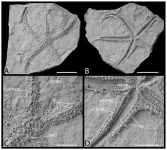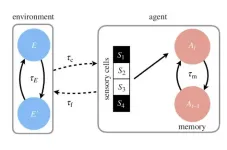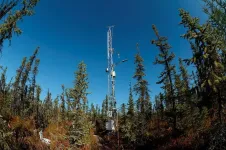(Press-News.org) A study published in PeerJ Life and Environment has reshaped our understanding of the evolutionary history of sea stars, particularly the family Asteriidae. The study, titled Phylogenetic and taxonomic revisions of Jurassic sea stars support a delayed evolutionary origin of the Asteriidae, introduces new findings that challenge longstanding assumptions about the evolutionary timeline of these marine invertebrates.
Sea stars of the superorder Forcipulatacea, comprising approximately 400 species, are integral to marine ecosystems. Over the past century, scientists have debated the systematics of this group, leading to varying classifications. This new research reassesses six well-preserved Jurassic sea star fossils and reveals that none of these Jurassic taxa belong to modern families like Asteriidae. Instead, they represent stem-forcipulatids, suggesting that Asteriidae likely originated later in the Late Cretaceous, rather than the Jurassic, as previously thought.
Key Findings:
Comprehensive Phylogenetic Reassessment: The study employed cutting-edge phylogenetic methods to analyses 42 fossil and extant sea star species, creating the largest phylogenetic dataset for Forcipulatacea to date. This comprehensive matrix of 120 morphological traits provided a fresh perspective on the evolution of this group.
Discovery of New Genera: Researchers described two new Jurassic sea star genera, Forbesasterias and Marbleaster, which contribute to our understanding of early sea star diversity and morphology.
Delayed Origin of Asteriidae: The research concludes that Asteriidae, the largest family within Forcipulatacea, and the third largest family of sea stars, likely evolved during the Late Cretaceous, up to100 million of years after the Jurassic species analyzed in this study. This contradicts previous assumptions that placed the origin of Asteriidae in the Triassic or Early Jurassic.
Early Diversity of Forcipulatacea: The findings also suggest that Forcipulatacea was more diverse in its early evolutionary stages than previously believed, providing new insights into the adaptive radiation of these species.
Methodology:
The research utilized a Bayesian tip-dating analysis incorporating the fossilized birth-death process to estimate evolutionary relationships and timelines. This method enabled the time calibration of the phylogenetic tree, resulting in a more accurate representation of the evolutionary history of the group.
Lead author Dr. Marine Fau noted, “Our study reshapes how we think about the evolutionary trajectory of one of the most significant clades of sea stars. The delayed origin of Asteriidae has major implications for understanding the diversification of marine species in the Mesozoic era.”
Implications for Marine Biology:
The findings from this research have wide-ranging implications for the field of marine biology, especially for paleontologists and evolutionary biologists. By identifying these Jurassic sea stars as stem-forcipulatids, the study pushes back the timeline for the evolution of modern sea star families and opens new avenues for future research into how these ancient species adapted to their environments.
END
New research reveals delayed evolutionary origin of Asteriidae sea stars
2024-10-31
ELSE PRESS RELEASES FROM THIS DATE:
A paper-aluminum combo for strong, sustainable packaging
2024-10-31
Takeout containers get your favorite noodles from the restaurant to your dining table (or couch) without incident, but they are nearly impossible to recycle if they are made from foil-lined plastics. Research published in ACS Omega suggests that replacing the plastic layer with paper could create a more sustainable packaging material. The researchers used mechanical demonstrations and computer simulations to identify paper-aluminum laminate designs that won’t compromise on performance.
Protective packaging, like containers made ...
A novel neural network for preserving cultural heritage via 3D image reconstruction
2024-10-31
Relief carvings or relief sculptures are cultural heritage objects with figures that protrude from a background such as a wall or slab, creating a sense of depth. Commonly found at historical sites worldwide, these artworks are considered to be of immense historical and cultural value. Unfortunately, many such relief carvings at heritage sites across the world suffer from varying degrees of damage and deterioration over time. While modern 3D scanning and photogrammetry techniques can digitally preserve their current form, they cannot restore the original appearance of these carvings before damage. Additionally, traditional methods for restoring ...
Sleep apnea contributes to dementia in older adults, especially women
2024-10-31
A common yet underdiagnosed sleep disorder contributes to the development of dementia among adults — particularly women, a Michigan Medicine study suggests.
Investigators uncovered this by examining survey and cognitive screening data from more than 18,500 adults to determine the potential effect of known or suspected obstructive sleep apnea on the risk for dementia.
Obstructive sleep apnea is a chronic sleep disorder characterized by episodes disrupted or restricted breathing during sleep.
For all adults age 50 and older, having known obstructive sleep apnea or its symptoms — as people often do not know they have the problem ...
The silk thread that can turn clothes into charging stations
2024-10-31
Imagine a sweater that powers electronics to monitor your health or charge your mobile phone while running. This development faces challenges because of the lack of materials that both conduct electricity stably and are well suited for textiles. Now a research group, led by Chalmers University of Technology in Sweden, presents an ordinary silk thread, coated with a conductive plastic material, that shows promising properties for turning textiles into electricity generators.
Thermoelectric textiles convert temperature differences, for example between our bodies and the surrounding ...
Glaucoma drug shows promise against neurodegenerative diseases, animal studies suggest
2024-10-31
A drug commonly used to treat glaucoma has been shown in zebrafish and mice to protect against the build-up in the brain of the protein tau, which causes various forms of dementia and is implicated in Alzheimer’s disease.
Researchers in the UK Dementia Research Institute at the University of Cambridge screened more than 1,400 clinically-approved drug compounds using zebrafish genetically engineered to make them mimic so-called tauopathies. They discovered that drugs known as carbonic anhydrase inhibitors – of which the glaucoma drug methazolamide is one – clear tau build-up and reduce signs of the disease in zebrafish and mice carrying the mutant forms of tau ...
Human proteins identified that explain inter-individual differences in functional brain connectivity
2024-10-31
BIRMINGHAM, Ala. – A long-standing goal of neuroscience is to understand how molecules and cellular structures on a microscale give rise to communication between brain regions at the macroscale. A study published in Nature Neuroscience now identifies, for the first time, hundreds of brain proteins that explain inter-individual differences in functional connectivity and structural covariation in the human brain.
“A central goal of neuroscience is to develop an understanding of the brain that ultimately describes the mechanistic basis of human cognition and behavior,” said Jeremy Herskowitz, Ph.D., associate professor in the University of Alabama at Birmingham ...
A newly developed algorithm shows how a gene is expressed at microscopic resolution
2024-10-31
They say a picture is worth a thousand words.
A new method, developed by University of Michigan researchers, creates images that are worth many gigabytes of data, which could revolutionize the way biologists study gene expression. Seq-Scope, developed by Jun Hee Lee, Ph.D., Hyun Min Kang, Ph.D., and their colleagues, was first described in Cell in 2021 as the first method to analyze gene expression at sub micrometer-scale spatial resolution.
To compare, a single human hair ranges from 20 to 200 micrometers in width.
The team has since improved Seq-Scope, making it more versatile, ...
Why elephants never forget but fleas have, well, the attention span of a flea
2024-10-31
Researchers at the Complexity Science Hub and Santa Fe Institute have developed a model to calculate how quickly or slowly an organism should ideally learn in its surroundings. An organism’s ideal learning rate depends on the pace of environmental change and its life cycle, they say.
Every day, we wake to a world that is different, and we adjust to it. Businesses face new challenges and competitors and adapt or go bust. In biology, this is a question of survival: every organism, from bacteria to blue whales, faces the challenge of adapting to environments that ...
Childhood neglect associated with stroke, COPD, cognitive impairment, and depression
2024-10-31
Toronto, ON, – New research from the University of Toronto found that childhood neglect, even in the absence of childhood sexual abuse and physical abuse, is linked with a wide range of mental and physical health problems in adulthood.
“While a large body of research has established the detrimental impact of childhood physical and sexual abuse on adult health outcomes, much less is known about whether neglect, in the absence of abuse, has similar negative outcomes,” said first author, Linxiao Zhang, a PhD student at the Factor-Inwentash Faculty of Social Work (FIFSW) at the University of Toronto. “Our research underlines the importance of health professionals ...
Landmark 20-year study of climate change impact on permafrost forests
2024-10-31
In perhaps the first long-term study of CO2 fluxes in northern forests growing on permafrost, an Osaka Metropolitan University-led research team has found that climate change increased not only the sources of carbon, but also the CO2 sinks.
The 20-year observation from 2003-2022 in the interior of Alaska showed that while CO2 sinks turned into sources during the first decade, the second decade showed a nearly 20% increase in CO2 sinks.
Graduate School of Agriculture Associate Professor Masahito Ueyama and colleagues found that warming led to wetness, which in turn aided the growth of black spruce trees. During photosynthesis, the growing trees were using the increasing ...






